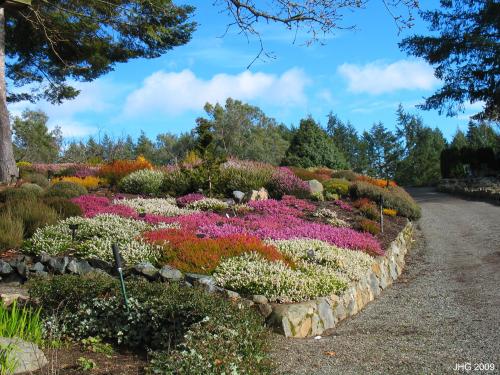My mother was born in the Vancouver(zone 8a) area and grew up in a fairly mild climate which is that of the lower mainland. She learned to love the flowers and other plants which grew abundantly there. When she married, she and my father decided to move to Prince George(zone3a) which is located in the center of British Columbia. No longer did she see the flowers she grew up with as the climate was much colder. When my parents built their permanent home they had a garden and of course mom wanted some of her favorite plants there.

English or Common Primrose like those in my mothers gardens
When my grandparents visited from the coast they brought with them two plants, a clump of blue Siberian Iris and some butter colored English or Common Primroses(Primula vulgaris). This was my introduction to Primula species which has fascinated me ever since. Every year in the spring I am reminded of my mothers beloved English Primroses as they bloom before any other Primula.

Primulas Peeping Out From Under a Dusting of Snow.
This Primula may be called common but it is not seen as much as you might think for a long time it was seen as an old fashioned plant and newer more exciting types came into fashion, most often the Polyanthus which you see sold at every grocer and florist shop. Recently people have renewed their interest in English Primroses and exciting old forms are now available at garden centers everywhere. Old Double forms such as Dawn Ansell(white) and April Rose(red) and many others are making a return to the garden here.

Double Primulas bloom a little later.

Primula 'Hereford'
Primula vulgaris has been with us for a very long time, the Romans knew this plant and Pliny wrote about it as being a panacea for what ailed his patients. Extracts of it were commonly used for muscular complaints, paralysis and gout. It is not surprising it would have been used as it grows in a wide geographic area from Ireland through to the Ukraine and the south as far as Lebanon. it grows in many places; wooded pastures, copses, meadows being where it is found. So popular was collecting this plant in the wild that laws have been passed to protect it form being removed completely from where is grows.

Two Color Forms Growing in my Backyard.
Fortunately for us these are really easy plants to grow and divide. They need a fertile, nutrient rich moisture retaining soil for their best showing. I have noticed the lighter colored flowers bloom first, are often deliciously fragrant and are slightly more vigorous. to have a beautiful display all you have to do is remove the older leaves when the new ones start to grow and this keeps them tidy. The best way to get more plants is to divide your own or a friends, one plant can be separated into many new ones.

This planting was created from dividing 2 plants.
The best use for this plant is in masses inter-planted with other later growing perennials for later color. They also can be used as an attractive edging which i have seen in a couple of places here.

An Example of Primulas used as Edging near Playfair Park.
If you want to see more Primulas, Government House has several varieties on their gardens, look about at older houses and you might be rewarded with the sight of some of the buttery yellow plants that have lived for many years.
Links For This Week:
All you might want to know about Primula vulgaris:
http://en.wikipedia.org/wiki/Primula_vulgaris
Government House is a treasure trove of fantastic plants. Something new to see anytime of the year. Free to all with parking.
See you again on Wednesday for new clues to lead you to the identity of the next plant.







































 Stumble It!
Stumble It!






